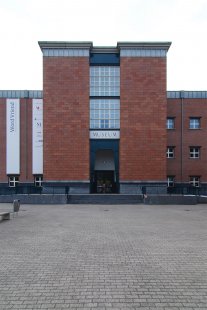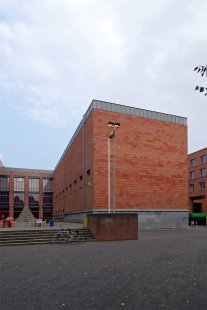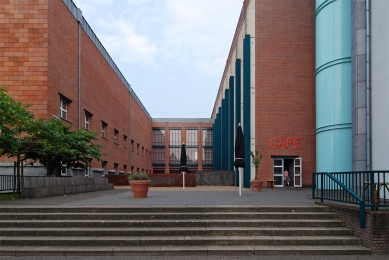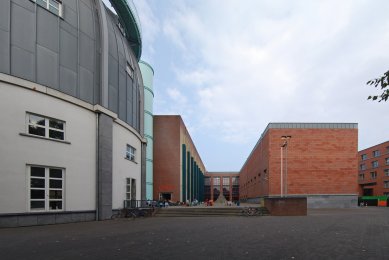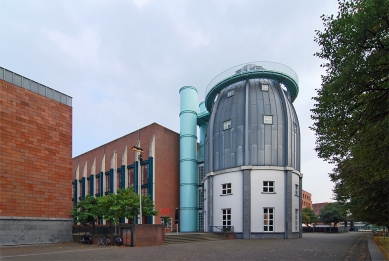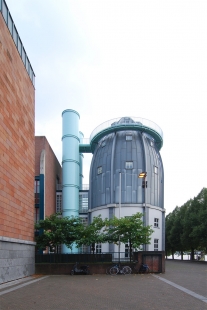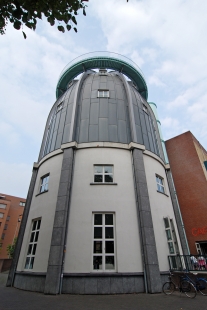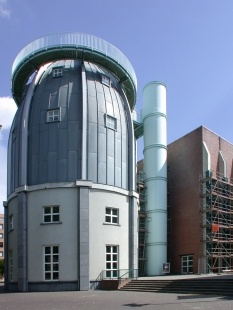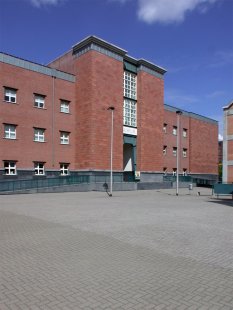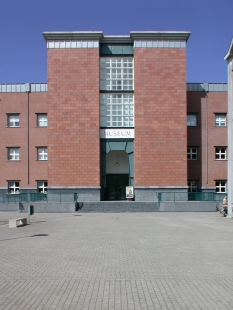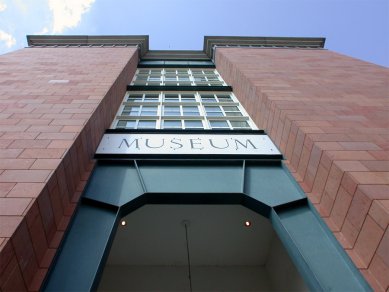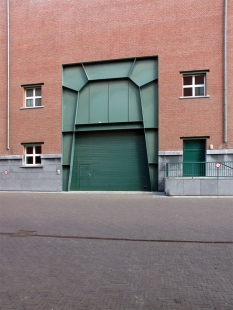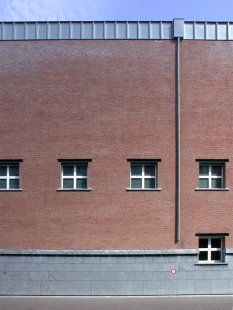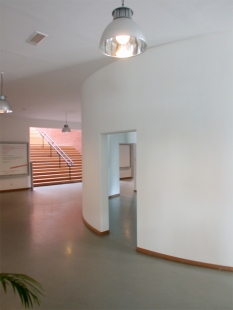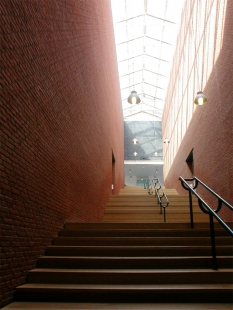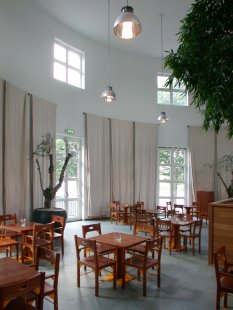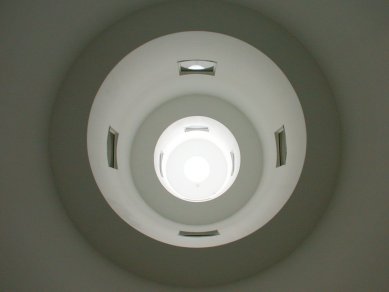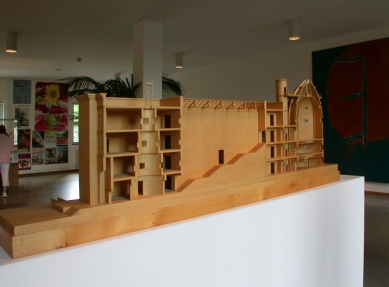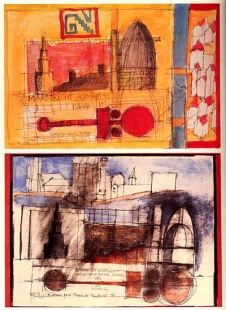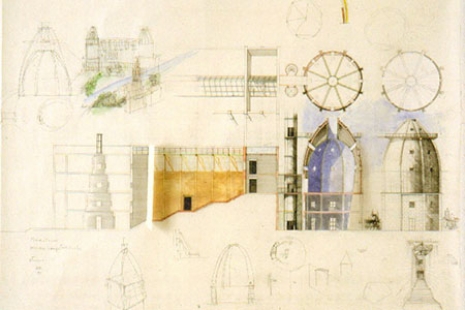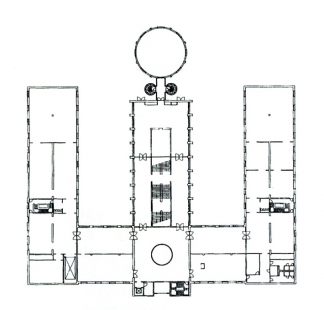
Bonnefanten Museum

Muzeum bylo založeno nizozemskou provincií Limburg v roce 1884 jako historické a archeologické muzeum. Název muzea Bonnefanten je odvozen z francouzštiny 'bons enfants' ('hodné děti'), což byla přezdívka bývalého kláštera, v němž muzeum sídlilo v období 1951-78. V roce 1995 se pak muzeum přestěhovalo na svou nynější adresu na protější břeh historického centra Maastrichtu do bývalého areálu keramické továrny 'Sphinx/Société Céramique', kterou na počátku 90. let minulého století nahradil urbanistický projekt Jo Coenen. Nová muzejní budova na nábřeží Mázy (Maas) pochází od italského architekta Aldo Rossi, který navrhl přísně symetrickou dispozici s půdorysnou stopou ve tvaru písmene E. Celý soubor je završen 28 metrů vysokou centrální věží ve tvaru raketoplánu. Rossiho návrh může připomínat také kávovar, nábojnice, nebo hvězdářskou observatoř. Výklad zůstává na návštěvnících, ale každému se tato plechová dominanta vryje hluboko do paměti. Slouží jako podvědomě známý symbol propojující minulost se současností. Rossiho postmoderní tvorba totiž umí být současně velmi střízlivá i rozmarná, klasická i moderní. Muzeum, které bylo otevřeno v březnu 1995, představuje jedno z posledních děl významného italského „malujícího básníka, který se stal architektem“. Od roku 1999 se původně historické a archeologické muzeum zaměřuje výhradně na vystavování umění.
The Maastricht Museum is situated on the banks of the river Maas (the Dutch name op the Meuse) in the suburb which has been linked to the city since ancient times by the Roman bridge from which the city gets its name (Masa tractum).
The museum is composed of three parts: the central building is flanked by a cylindrical body covered by a high dome; this is crowned by a belvedere from which the river and the city on the opposite bank can be admired.
In the building there is a long staircase covered in wood; this and other features are the very substance of this architecture which reminds us of the seafaring tradition of the Dutch cities as well as of the great river which crosses Europe and flows through Maastricht.
How difficult and indescribable are both architecture and memory! For this reason I would like to attempt a personal and necessarily incomplete description of my attempt to see the museum in a light that avoids those problems which, because of the word itself, seem to have pathological associations rather than advanced ones. Perhaps I will end up by demonstrating that the museum, like the histories of all of us, like every vice and virtue and everything that has to the limited dimensions of a marble slab which only the foolish minds of the Enlightenment wished to measure in metres and centimeters. This museum is an attempt to reject this foolishness.
The first room which the visitor encounters is the entrance hall+ it has the distinctive form of a telescope. This is a typical example of a lichtraum, the precedent for Zürich University; moreover this form is not typically northern, but represents the most important contact between Spanish architecture and the colonies. Thus there is a direct link between Vermeer and Zurbarán. The light of the houses in the monasteries preserves in the monument the ephemeral nature of both daily life and the religious one. This room, which fills the height of the building, is decorated with an aquamarine material; the light and colour appear to cause its very substance to disintegrate.
From the entrance hall the visitor proceeds directly to the living heart of the museum, which is entered with fear and trepidation. How difficult it is, almost impossible I daresay, to define this essence! Is the museum a collection of mementoes of life or is it itself part of our lives? My architecture leaves an open verdict in this regard. Nonetheless, the substance of the museum is the origin and end of our cultural decadence.
Now let us climb the stairs. It is hardly worth mentioning that this steep and awkward staircase. In the ancient Dutch tradition, is linked to the world, knowing only too well that beyond geometry there is only a shipwreck. And drawing a parallel between the two great seafaring nations I would like to quote the words of the great Portuguese poet: “Portugal is the country where the land ends and the sea begins”. And, in fact, do we not confound the buildings of Macao, Singapore and northern Japan with those of these countries that are so thoroughly European and yet so exotic?
At the top of the stairs, among energetic young people and breathless senior citizens, we may admire the skilful what the director has displayed the exhibits. Far from being a celestial director, he is a true curator who is sensitive to the different emotional levels of light and beauty. Never in the history of architecture have larger works been seen which did not correspond to a sort of alliance between the patron and the artist, the bureaucrat and the engineer.
I will not carry on with the description, even if the basic tenet of Latin literature, as in the case of virgil, was description rather than invention. But I cannot dwell upon the sorrows of Dido which have already been described to excess by the great Racine. Rather let us consider a number of the features which impress visitors, even the hasty ones, in the museum as a whole. Were you to ask the simplest person in Europe, there would only be one answer: the dome.
There are two main reasons for the magnificence of the dome: the first is its link with the architectural tradition of the classical world tight up to the nineteenth century Turinese architect Alessandro Antonelli; the second that between river and sea it boldly signals the lie of the land in that country.
But now, just as if we were standing on the belvedere, we can view the museum as a whole, perhaps a lost whole which we only recognize thanks to those fragments of our lives which are also fragments of art and Europe of bygone days.
The Maastricht Museum is situated on the banks of the river Maas (the Dutch name op the Meuse) in the suburb which has been linked to the city since ancient times by the Roman bridge from which the city gets its name (Masa tractum).
The museum is composed of three parts: the central building is flanked by a cylindrical body covered by a high dome; this is crowned by a belvedere from which the river and the city on the opposite bank can be admired.
In the building there is a long staircase covered in wood; this and other features are the very substance of this architecture which reminds us of the seafaring tradition of the Dutch cities as well as of the great river which crosses Europe and flows through Maastricht.
How difficult and indescribable are both architecture and memory! For this reason I would like to attempt a personal and necessarily incomplete description of my attempt to see the museum in a light that avoids those problems which, because of the word itself, seem to have pathological associations rather than advanced ones. Perhaps I will end up by demonstrating that the museum, like the histories of all of us, like every vice and virtue and everything that has to the limited dimensions of a marble slab which only the foolish minds of the Enlightenment wished to measure in metres and centimeters. This museum is an attempt to reject this foolishness.
The first room which the visitor encounters is the entrance hall+ it has the distinctive form of a telescope. This is a typical example of a lichtraum, the precedent for Zürich University; moreover this form is not typically northern, but represents the most important contact between Spanish architecture and the colonies. Thus there is a direct link between Vermeer and Zurbarán. The light of the houses in the monasteries preserves in the monument the ephemeral nature of both daily life and the religious one. This room, which fills the height of the building, is decorated with an aquamarine material; the light and colour appear to cause its very substance to disintegrate.
From the entrance hall the visitor proceeds directly to the living heart of the museum, which is entered with fear and trepidation. How difficult it is, almost impossible I daresay, to define this essence! Is the museum a collection of mementoes of life or is it itself part of our lives? My architecture leaves an open verdict in this regard. Nonetheless, the substance of the museum is the origin and end of our cultural decadence.
Now let us climb the stairs. It is hardly worth mentioning that this steep and awkward staircase. In the ancient Dutch tradition, is linked to the world, knowing only too well that beyond geometry there is only a shipwreck. And drawing a parallel between the two great seafaring nations I would like to quote the words of the great Portuguese poet: “Portugal is the country where the land ends and the sea begins”. And, in fact, do we not confound the buildings of Macao, Singapore and northern Japan with those of these countries that are so thoroughly European and yet so exotic?
At the top of the stairs, among energetic young people and breathless senior citizens, we may admire the skilful what the director has displayed the exhibits. Far from being a celestial director, he is a true curator who is sensitive to the different emotional levels of light and beauty. Never in the history of architecture have larger works been seen which did not correspond to a sort of alliance between the patron and the artist, the bureaucrat and the engineer.
I will not carry on with the description, even if the basic tenet of Latin literature, as in the case of virgil, was description rather than invention. But I cannot dwell upon the sorrows of Dido which have already been described to excess by the great Racine. Rather let us consider a number of the features which impress visitors, even the hasty ones, in the museum as a whole. Were you to ask the simplest person in Europe, there would only be one answer: the dome.
There are two main reasons for the magnificence of the dome: the first is its link with the architectural tradition of the classical world tight up to the nineteenth century Turinese architect Alessandro Antonelli; the second that between river and sea it boldly signals the lie of the land in that country.
But now, just as if we were standing on the belvedere, we can view the museum as a whole, perhaps a lost whole which we only recognize thanks to those fragments of our lives which are also fragments of art and Europe of bygone days.
Aldo Rossi, July 1991
0 komentářů
přidat komentář


